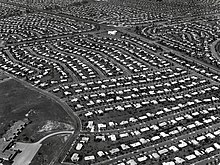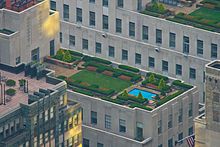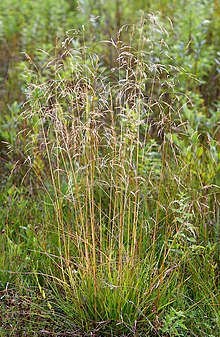Lentis/Lawn Care in America: Intensive Agriculture, No Harvest
From the smell of fresh lawn clippings to backyard games of football, lawns serve as a ubiquitous part of life in much of the United States. Beyond a simple plot of vegetation, lawns represent an American dream of home-ownership.
An unnatural phenomenon, mono-culture (single crop) lawns require an intensive amount of irrigation and labor to maintain. The lawn care industry has grown with the adoption of such lawns, annually raking in billions of dollars, while also encouraging the culture surrounding lawns. This chapter examines how lawns grew to what they are today, the impacts that they have across the U.S., and what the future of lawns could look like.
History
[edit | edit source]Birth of Lawns in America
[edit | edit source]
Lawns originated in the early 1700s as an expensive and exclusively aristocratic landscape due to the crude maintenance technology, cattle and scythes, of the time. The ability to dedicate not only land but also labor away from crops and livestock was a strong symbol of status.[1][2] Early Americans able to travel envied these landscapes. Thomas Jefferson in 1808 constructed his Monticello Estate with one of the first lawns in the new world serving as an icon for early American architecture and landscaping.[3]
Early technology began to break down the massive barrier of entry for common people to maintain their own lawns. In 1830, Edward Beard Budding invented the first lawn mower as an improvement over the scythe. Initially expensive and cumbersome, Budding's invention would be dramatically improved over the next decade.[4] In 1841, Andrew Jackson (AJ) Downing wrote the first American homeowner's lawn care guide, "Treatise on the Theory and Practice of Landscape Gardening". [5] This technology and education tandem set up a vivacious 19th century for the American lawn.
19th Century
[edit | edit source]The first lawn sprinkler, invented in 1871, was so efficient that cities were forced to conserve water during droughts, discouraging citizens from watering their lawns around the clock. At the World's Fair held in Philadelphia in 1876, the USDA, a lawn care advocate, showcased grasses and maintenance techniques to educate the masses.[1] Another spike in popularity manifested itself in the construction of the first American golf courses. Especially influential was, to this day, the nation's longest continuously operated course, St. Andrews, in New York (1888).[6] Pristine courses in the public eye exploded the lawn's popularity; houses began to pop up along courses, and everyone wanted fairway-quality grass in their front yard. This combination of technology, education, and publicity formed the first true boom of lawn culture in America.
Impact of the World Wars
[edit | edit source]
During WW1, victory gardens ebbed the progress of lawns by monopolizing front yards with fruits and vegetables.[7] This regression was soon recovered by the Fair Labor Standards Act of 1938. This mandated the 40 hour work week, allowing homeowners more time spent at home for leisure or tending to their lawns.[8]
World War II grew the popularity of lawns more radically than any period in history. In between the two wars, the lawn care giant Scotts began delivering grass seed by mail to homes and introduced the first fertilizer.[9] The increased availability, enhanced nutrients, and mass production of lawn food formed a great foundation for the lawn care industry to grow.
Returning from WWII, the Servicemen's Readjustment Act of 1944 allowed WWII veterans to obtain cheap mortgages for homes.[10] Due to the demand for housing, the first true suburban towns began to develop. Real estate developer William Levitt created what is considered the father of modern suburbia, Levittown. These massive communities provided a lawn, grass seed, and fertilizer to each home and required residents to mow their lawn at least once a week.[11] This new type of town imprinted lawns as a standard in American culture.
Growth of Large-Scale Lawn Care Industry
[edit | edit source]Products and technology drove the growth of lawns through the 20th century. With already established demand, the increase in availability and efficacy of fertilizers and herbicides blew lawn care out of proportion. After Scotts' 1928 marketing of the first lawn-specific fertilizer[9] the lawn care companies began searching for other improvements in the industry. The development of herbicides also shaped public conception of lawns. DDT and 2,4-D (dichlorophenoxyacetic acid), killed both weeds and other plants previously considered acceptable. This included nitrogen-fixing clovers and other plants helpful to lawn growth. Herbicide companies, aware of this development, began marketing campaigns to villainize these plants as weeds while also encouraging homogeneous grass.[12]
Impact
[edit | edit source]Land Usage
[edit | edit source]Turf grass is estimated to cover a staggering 1.9% (163,812 km2)of the continental United States.[13] This makes turf grass the largest irrigated "crop" in the U.S., the next being corn which covers 43,000 of 202,000 km2 total irrigated cropland area.[13] Turf grass can be found in neighborhood yards, highway roadsides and medians, parks, airports and many other locations. Turf grass, while mainly serving aesthetic purposes, provides clear lines of site beside roads and helps prevent runoff and water pollution.
Turf grass is one of the cheapest ground covers to install, at about $132 per 100 m2, but it is also one of the most expensive to maintain, costing $2,117 per 100 m2/year. [14] Efforts have been proposed to reduce these costs on publicly owned land by mowing less or replacing the turf with native plants and flowers. Such alternatives would reduce cost and increase biodiversity (planting flowers for pollinating insects) while maintaining an attractive aesthetic.[15] [16]
Water Consumption
[edit | edit source]Turf grass needs around 2.54cm/week of water in order to live. Taking regional climates into account, this leads to an estimated 695 to 900 liters of water per person per day or 99,130 Mm3 per year for lawn maintenance in the U.S.[13] According to the USDA, only 71,748.22 Mm3 of water was used in 2013 for irrigated cropland.[17] Many turf grasses are not native to the environments in which they are placed, necessitating these irrigation levels.
California's State Government enacted emergency drought restrictions from 2014-2017 in response to severe droughts. Some of these restrictions have remained in place in order to preserve an environment of conservatism for future droughts. These restrictions include a ban on the irrigation of lawns within 48 hours of a rainstorm and the irrigation of roadside turf.[18] Push-back against these restrictions required the state to enact protections for residents from Home Owners Associations (HOA). These restrictions prevent HOA's from punishing residents who install drought-tolerant landscapes or allow their lawns to die off during drought emergencies. [19]
Carbon Sequestration
[edit | edit source]
Lawns do have environmental benefits as they remove carbon-dioxide from the air through carbon sequestration. Turf grass in the continental U.S. pulls between 10.4 to 25.7 Tg of carbon from the air per year. [13] However, the net reduction of carbon-dioxide drops when considering the maintenance required for lawns. The fertilizer industry adds an estimated 2.9 Tg C/yr while the use of gas-powered mowers adds 0.7 to 1.1 Tg C/yr. If these lawns were not maintained, carbon sequestration would decrease to 1.2 Tg C/yr as most turf grass throughout the country can not survive without fertilizer and irrigation.[13]
Green roofs, covered with grass and other plants, have been used in cities to provide carbon sequestration in pollution heavy cities and to reduce the the urban heat island effect through evaporative cooling.
Chemical Usage
[edit | edit source]Many herbicides and pesticides are potentially harmful to both humans and the environment. Some herbicides and pesticides are suspected to be endocrine disruptors, a classification of chemicals increasingly linked to effects such as immune suppression, reproductive abnormalities and even cancer [20]. Even Scotts Miracle-Gro, a large lawn care company that produces fertilizer, herbicides and insecticides, stated in their 2001 annual report that “[they] cannot assure that [their] products, particularly pesticide products, will not cause injury to the environment or to people under all circumstances”. [21]
Despite this, a tendency for chemical overuse has emerged around lawn care. In 1997 the average household use of chemicals per acre (3.238 kg/ha) was almost 3 times that of agriculture (9.127 kg/ha).[22] Such overuse is often tied to lawn maintenance being motivated by its connection to community rather than profit. Lawn care companies have capitalized on this notion through clever marketing. [22]
Alternative Lawn Movements
[edit | edit source]
Recently, movements have grown that promote the use of ground covers and other grass-replacements as a way to counter the negative impacts of lawn use.
Many ground covers grow sideways and spread over the ground, requiring little mowing. They require much less water than traditional lawn grasses and usually remain green throughout the year. Some even provide chemical benefits, fixing levels of nitrogen or consuming more carbon than traditional grasses. Ground covers like clover, creeping thyme, and hosta are a great plant-it and leave-it method of lawn care.[23]
Ornamental grasses, mosses, and artificial turf are also appropriate alternatives. These options require little to no maintenance and consume much less water. Native grasses are attractive because they've evolved to grow in their respective environments, adapting to minimal water supplies. This also provides a wild or natural look that some value.[23]
Government Involvement
[edit | edit source]In drought-ridden regions or areas with low water supplies, extensive lawn irrigation is unsustainable. Local governments in many areas often establish water restrictions to limit water usage on a residential scale.
In drought heavy southern California, the Metropolitan Water District has offered $2 per square foot of lawn replaced with drought tolerant landscapes to cut back on irrigation requirements.[24] Acceptable replacements include native or drought-tolerant plants that also retain a pleasant aesthetic. Artificial turf is not allowed as it provides no ecological benefits and can increase the area's temperature. This particular effort was so successful that, when started in 2015, it was temporarily shut down due to lack of funds after initially allocating $239 million in rebates.[25]
Gardens
[edit | edit source]Individuals spend large sums of money on maintaining and improving their lawns each year. However, there is no harvest or any tangible, monetary benefit from the hard labor associated with lawn care. There have been efforts to encourage the use of gardens within the US. During the 2008 recession there was an increase of gardens, with a 15 to 20 percent uptick in seed sales, as people attempted to save money.[26] While the amount of effort required to maintain a garden isn't necessarily less than that of a traditional lawn, a garden produces food that can be eaten or sold, adding tangible value to the lawn.
Cultural Obstacles
[edit | edit source]The alternative lawn movement may not gain significant steam unless the social attitude towards it changes. Robbins and Sharp found that lawn owners commonly reported feeling an obligation to manage their private lawns to defend neighbors' property values and support "positive neighborhood cohesion" to hold "the neighborhood together".[22]
The house with knee-high grasses is well-known in every community. Homeowner's associations often have rules detailing the minimum amount of lawn maintenance required to live in their neighborhood. Some neighborly disagreements even escalate in severity until eventually a resolution is reached in court. Under pressure from their HOA, a Loudoun County, Virginia couple filed suit in order to protect their prized backyard meadow. [27]
References
[edit | edit source]- ↑ a b Hansen, J. (2016, October 04). The History of the American Lawn. Retrieved from https://www.pennington.com/all-products/grass-seed/resources/the-history-of-the-american-lawn
- ↑ Lowen, S. (1991, September). The Tyranny Of The Lawn. American Heritage, 42(5). Retrieved from https://www.americanheritage.com/content/tyranny-lawn-0
- ↑ Monticello's West Lawn. (n.d.). Retrieved from https://www.monticello.org/
- ↑ A History of the World - Object : Lawnmower, Stroud. (n.d.). Retrieved from http://www.bbc.co.uk/ahistoryoftheworld/objects/NI2ZjBwpTcqYdtpXFnIzUQ
- ↑ Downing, A. J. (1844). A treatise on the theory and practice of landscape gardening: Adapted to North America. New York: Wiley and Putnam.
- ↑ First In Golf Since 1888 . (2018). Retrieved from https://www.saintandrewsgolfclub.com//
- ↑ Schumm, L. (2014). America’s Patriotic Victory Gardens - HISTORY. Retrieved December 11, 2018, from https://www.history.com/news/americas-patriotic-victory-gardens
- ↑ Wage and Hour Division (WHD). (2016, September). Retrieved from https://www.dol.gov/whd/regs/compliance/hrg.htm
- ↑ a b Scotts Miracle-Gro. (n.d.). History - ScottsMiracle-Gro. Retrieved December 11, 2018, from https://scottsmiraclegro.com/company/history/
- ↑ History of the GI Bill. (2018, May 03). Retrieved from https://militarybenefits.info/history-of-the-gi-bill/
- ↑ Gutis, P. (1987). LEVITTOWN, L.I., AT 40: ONCE A SOLUTION, NOW A PROBLEM - The New York Times. Retrieved December 11, 2018, from https://www.nytimes.com/1987/09/21/nyregion/levittown-li-at-40-once-a-solution-now-a-problem.html
- ↑ Kolbert, E. (2008). Turf War | The New Yorker. Retrieved December 11, 2018, from https://www.newyorker.com/magazine/2008/07/21/turf-war-elizabeth-kolbert
- ↑ a b c d e Milesi, C., Elvidge, C. D., Dietz, J. B., Tuttle, B. T., Nemani, R. R., & Running, S. W. (2012). A STRATEGY FOR MAPPING AND MODELING THE ECOLOGICAL EFFECTS OF US LAWNS.
- ↑ Latocha, Piotr. (2002). Cost comparison - initial and maintenance costs of lawns and ground cover plants. Warsaw University of Life Sciences - SGGW, Horticulture and Landscape Architecture. 39-42.
- ↑ Barringer, F. (2007). Wildflowers Find Favor With Highway Gardeners - The New York Times. Retrieved December 7, 2018, from https://www.nytimes.com/2007/08/29/us/29highway.html
- ↑ Connif, R. (2013). Green Highways: New Strategies To Manage Roadsides as Habitat - Yale E360. Retrieved December 7, 2018, from https://e360.yale.edu/features/green_highways_new_strategies_to_manage_roadsides_as_habitat
- ↑ Richardson, K. (2017). HOA Homefront: Drought emergency is over, so back to business as usual? – Orange County Register. Retrieved December 8, 2018, from https://www.ocregister.com/2017/04/17/hoa-homefront-drought-emergency-is-over-so-back-to-business-as-usual/
- ↑ Dwyer, C. (2017). Gov. Jerry Brown Lifts Drought Emergency For Most Of California : The Two-Way : NPR. Retrieved December 8, 2018, from https://www.npr.org/sections/thetwo-way/2017/04/07/523031241/gov-jerry-brown-lifts-drought-emergency-for-most-of-california
- ↑ Richardson, K. (2017). HOA Homefront: Drought emergency is over, so back to business as usual? – Orange County Register. Retrieved December 8, 2018, from https://www.ocregister.com/2017/04/17/hoa-homefront-drought-emergency-is-over-so-back-to-business-as-usual/
- ↑ Aktar, M. W., Sengupta, D., & Chowdhury, A. (2009). Impact of pesticides use in agriculture: their benefits and hazards. Interdisciplinary toxicology, 2(1), 1-12.
- ↑ Scotts. (2001). The Scotts Miracle-Gro Company 10-K. Retrieved December 5, 2018, from https://www.sec.gov/Archives/edgar/data/825542/000095015207009349/l28885ae10vk.htm
- ↑ a b c Paul Robbins & Julie T. Sharp (2003) Producing and Consuming Chemicals: The Moral Economy of the American Lawn, Economic Geography, 79:4, 425-451
- ↑ a b Grass Lawn Alternatives for an Eco-Friendly Backyard. Retrieved December 9, 2018 from https://gilmour.com/grass-alternatives-backyard-lawn.
- ↑ Goldenstein, T. and Morin, M. (2015). Southland water district OKs $350 million more for lawn replacement rebates. Retrieved December 9, 2018 from https://www.latimes.com/local/lanow/la-me-ln-mwd-rebate-20150526-story.html.
- ↑ Guerin, E. (2018). Audio: Still got a lawn? Here’s another chance to get paid to rip it out | 89.3 KPCC. Retrieved December 10, 2018, from https://www.scpr.org/news/2018/04/10/82195/still-got-a-lawn-here-s-another-chance-to-get-paid/
- ↑ Kolbert, E. (2008). Turf War | The New Yorker. Retrieved December 11, 2018, from https://www.newyorker.com/magazine/2008/07/21/turf-war-elizabeth-kolbert
- ↑ Sullivan, P. (August 6, 2018). In this subdivision, lawns must be mowed. But what about meadows? The Washington Post. Retrieved December 10, 2018 from https://www.washingtonpost.com/local/virginia-politics/in-this-subdivision-lawns-must-be-mowed-but-what-about-meadows/2018/08/03/a18e03bc-966c-11e8-810c-5fa705927d54_story.html.
